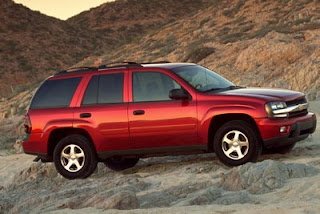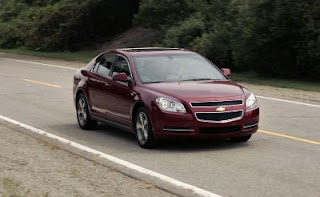Why Trading In Your Gas Guzzler May Not Make Sense
By Dennis Haak
05.12.2008
 Every time high gas prices are in the news, reporters inevitably find stories of people who are aghast at the prospect of paying $75 or $100+ to fill up the tank of their SUV or pickup every few days and want to trade their expensive, comfortable SUV in on a compact fuel miser that’s half the size with double the fuel economy. While this may may make economic sense when you run the numbers in some situations, many of the anecdotes cited in the popular media are not financially prudent at all. My service to you is to point out one obvious truth: you can buy a heck of a lot of gas for $5,000, even at $4.00 per gallon.
Every time high gas prices are in the news, reporters inevitably find stories of people who are aghast at the prospect of paying $75 or $100+ to fill up the tank of their SUV or pickup every few days and want to trade their expensive, comfortable SUV in on a compact fuel miser that’s half the size with double the fuel economy. While this may may make economic sense when you run the numbers in some situations, many of the anecdotes cited in the popular media are not financially prudent at all. My service to you is to point out one obvious truth: you can buy a heck of a lot of gas for $5,000, even at $4.00 per gallon.
Of course, high fuel prices pinch everyone, but folks who bought large, thirsty vehicles for image or convenience reasons rather than out of necessity for their family or business needs are mainly the ones who complain the loudest about how they want to trade in their Armada on something smaller. Of course, there is much more to the cost of owning and operating a vehicle than just fuel costs. Monthly payments, sales tax (in some states) maintenance, repairs, registration, and depreciation are other big-ticket items that car owners have to contend with. Paying attention to only fuel costs is doing yourself a disservice.
Let’s take a few hypothetical examples of when it would and would not be cost-effective to trade down to a smaller vehicle. For the sake of simplicity, I’ll even ignore registration, sales tax, maintenance, and repairs and focus solely on the purchase price, depreciation, and fuel costs for 15,000 miles at $4.00 per gallon based on the EPA-estimated combined fuel economy using the downward-adjusted 2008-equivalent figures.
For example, let’s assume that someone bought a 2007 Chevy Trailblazer LS 4×4 a year ago for $28,000. According to Edmunds, this truck is worth about $16,000 today, one year into a five year loan. Assuming that the buyer put 20% down ($5,600), the original loan balance was $22,400 and the current loan balance is $18,347 (assuming 60 months @ 4.9%). Assuming that the Trailblazer got the EPA-estimated combined mileage of 16 mpg, at $4.00 per gallon and 15,000 miles per year, the annual fuel cost would be $3,750. Over five years, fuel would cost $18,750.
 Then let’s say the person wants to buy a new Chevy Malibu LS four cylinder for $20,000 and puts 20% ($4,000) down and finance the $12,000 balance. With the same fuel price and miles-per-year assumptions, and at its EPA-estimated combined mileage of 25 mpg, the Malibu’s annual fuel cost is $2,400. Over five years, fuel would cost $12,000.
Then let’s say the person wants to buy a new Chevy Malibu LS four cylinder for $20,000 and puts 20% ($4,000) down and finance the $12,000 balance. With the same fuel price and miles-per-year assumptions, and at its EPA-estimated combined mileage of 25 mpg, the Malibu’s annual fuel cost is $2,400. Over five years, fuel would cost $12,000.
So, forgetting the purchase prices for a moment, the fuel cost difference is $6,750 over five years and $1,350 annually. That is $112.50 per month.
Now, we can’t forget that to make up for the Trailblazer’s $2,400 in negative equity (trading in the Trailblazer just one year into a five year loan) plus the 20% ($4,000) down for the Malibu means that you’ll be shelling out about $6,400 in cash to get out of the 2007 Trailblazer and into the 2008 Malibu, and that’s assuming that you move into a lightly-optioned Malibu. If you want more comfort/luxury features, you’ll have to step up to a Malibu LT, and that means more cash out. In fact, over five years, the cash difference is negligible. You’re also sacrificing the additional space and power that the Trailblazer could provide over the Malibu, not to mention the Trailblazer’s superior all-weather capabilities.
Of course, after the five years have passed, the more efficient Malibu will have broken even cost-wise, but until the five year point, the Trailblazer’s additional gasoline expenditures would roughly equal the cost to purchase the new Malibu.
There are other caveats associated the above example. Buying a used 2007 Malibu to replace the 2007 Trailblazer instead of a new 2008 model would make the cash outflow to purchase the more efficient vehicle much less. Also, replacing a guzzler with a more efficient car later in the guzzler’s loan (not after just one year) would eliminate the negative equity. Of course, if gas prices go beyond $4.00 per gallon, the more efficient vehicle gets more attractive financially. Lastly, replacing a paid-off inefficient vehicle that was about to be replaced anyway with a more efficient one is a prudent financial choice, as well as a more earth- and resource-friendly one.
The bottom line is that buyers are doing themselves a disservice if they do not do some simple arithmetic before spending thousands of dollars to “save” money that may – or may not – actually result in money savings. Even if buyers do the economic analysis, there will still probably be many folks who decide that gas prices are going nowhere but up, and who are tired of the steady drip-drip of money for fuel coming from their wallets, so they take a financial hit to get out of the guzzler and into something more “politically correct.”
COPYRIGHT Full Metal Autos – All Rights Reserved




